I began playing this game five days ago, having gone a little too long without playing any serious war-games. As with a lot of my war-gaming activity, I played this game solitaire. My ASL games with Michael are on hold as our schedules just haven’t matched up too well of late; most of the time we’ve got too many players so my multiplayer games come out at that time.
It feels odd writing this now because earlier today, I learnt that John Hill, the designer of Squad Leader, had died of a heart attack. Squad Leader was one of the stand-out games of the war-game era. Released in 1977, it sold upwards of 200,000 units, which is a huge number of copies, especially in today’s market. It had three expansion sets (or gamettes), and was revised into Advanced Squad Leader in 1985, a game that is still around today. It is, in short a significant game, and it’s sad that its designer is no longer with us.
My grasp on Squad Leader rules and tactics is fairly primitive, and isn’t particularly aided by my play of ASL. I play Squad Leader because I am fascinated by the history of games and seeing where games came from.
The scenario I played is the 5th of the original game, “Hill 621”. It introduces rules for half-tracks and Anti-Tank Guns, neither of which are particularly challenging. The scenario is 10 turns long, which is fairly standard for the original Squad Leader scenarios. I played it over several days, with a lot of breaks, so I can’t tell you how long it took to play. A few hours. The last few turns went by pretty fast, though!
The map uses three map-boards joined together. The Russians have a massive 48 squads! Against that, the eight squads of the Germans seems pretty pathetic, although the Germans would get reinforcements throughout the game – including a couple of Anti-Tank Guns, coming in by half-track.
The camera I used to take these photos isn’t the best, but let’s see if you can make out the blue Germans on the left and the brown Russians on the right:
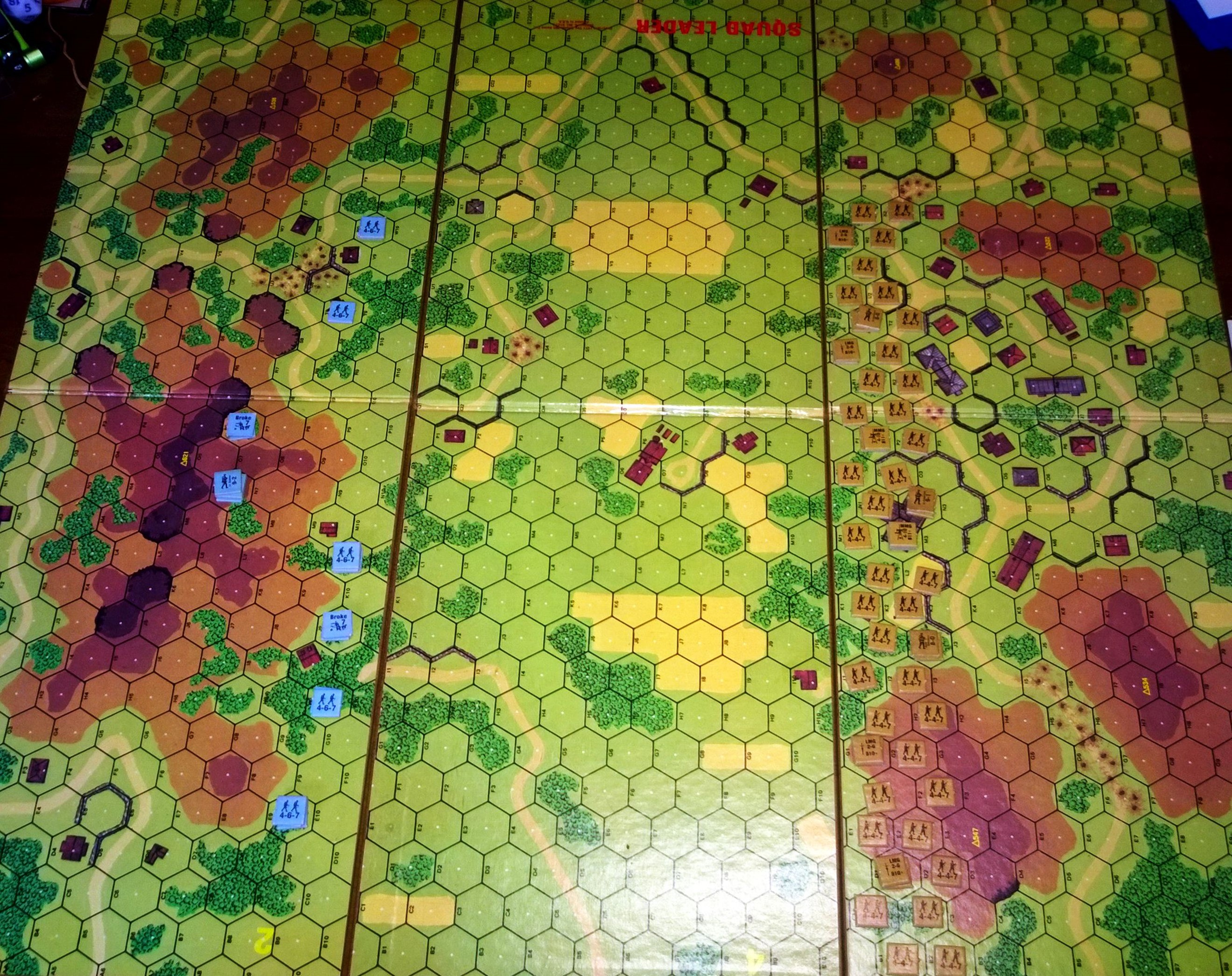
Oh, one other thing – some of the German units began broken. It wasn’t going to be an easy defence of Hill 621!
The objective for the Russians was to capture five of the seven Level 3 hexes on map 2. And so they started off crossing the fields near Minsk to try and capture the hill.
This scenario is set in 1944. The time of Operation Barbarossa is long past, and now the Germans are in the Great Retreat back to Berlin. This was part of the campaign that would be known as the Destruction of Army Group Center, and the Russians were trying to cut off the retreat routes for a large part of the German force. The Germans mustered a defence, but found themselves in a tricky situation when the Russians began to break-through and moved towards a set of ridges that overlooked the German communication lines.
The first major engagement of the battle came when the German tanks entered the fray from the south (bottom of the map) and began to overrun the exposed Russian troops…
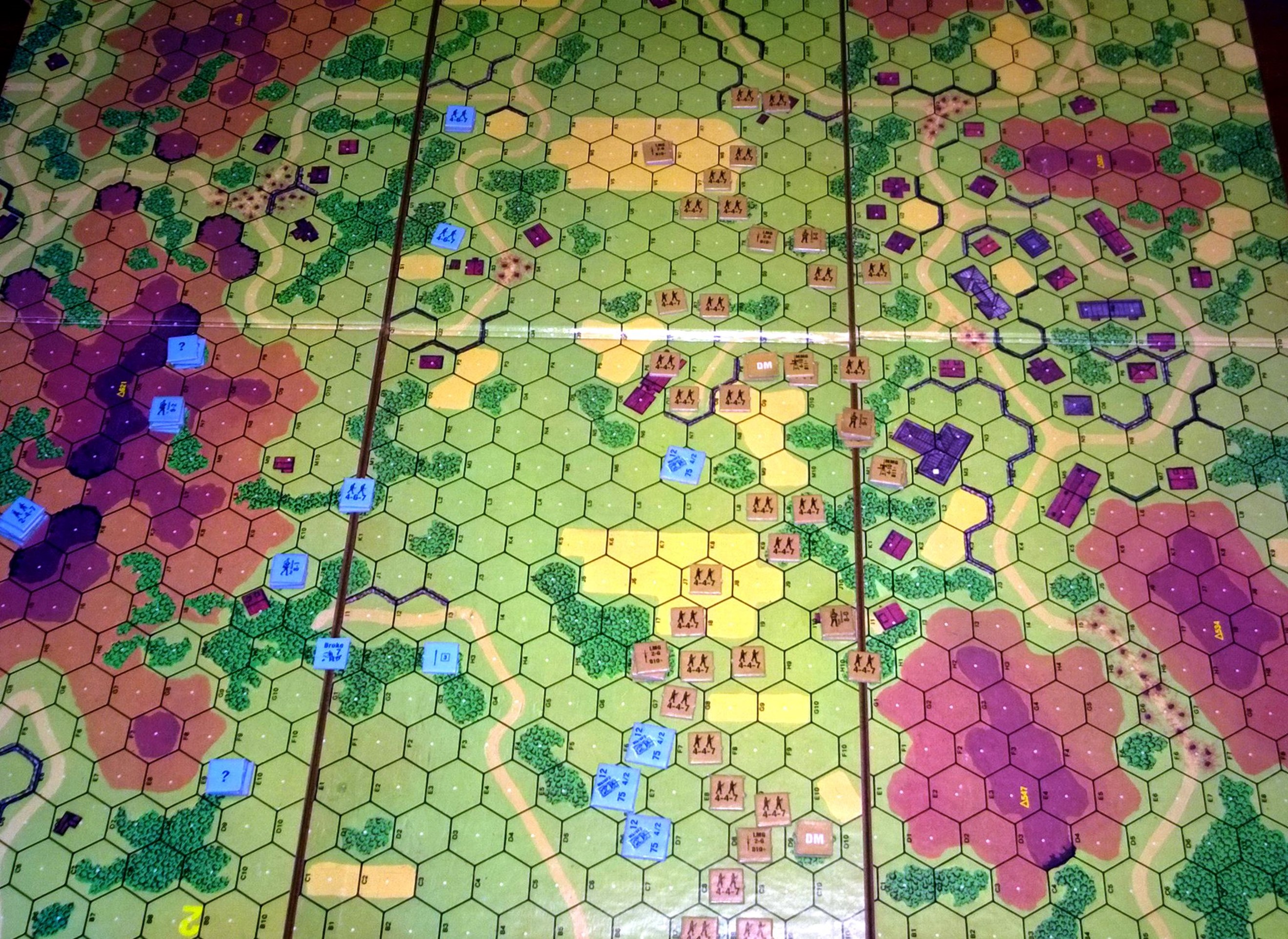
The solution to German tanks running unopposed around the battlefield? Bring on the Russian tanks!
The little codes on my tank counters read T-34 for the Russians and MkIVF2 for the Germans. There’s a lot more written about the tanks of World War II than I really want to think about; I’ve certainly never been a lover of hardware, so the role of each variety of tank in the war is something I only really learn about through these scenarios – and the extensive Chapter H summaries in Advanced Squad Leader. As far as the tanks went, these two seemed pretty analogous. If one tank could outmanoeuvre the other so as to shoot it from behind, it’d have a much better chance of destroying its opponent, but – for the most part – my tanks just lined up and shot at each other. I’m not really known for my impressive tactical skills!
Meanwhile, the Russian infantry, seeing that the German tanks were now somewhat distracted, flooded past them and began getting to the woodlands at the base of the ridge, taking out the few German units that had a forward defensive position.
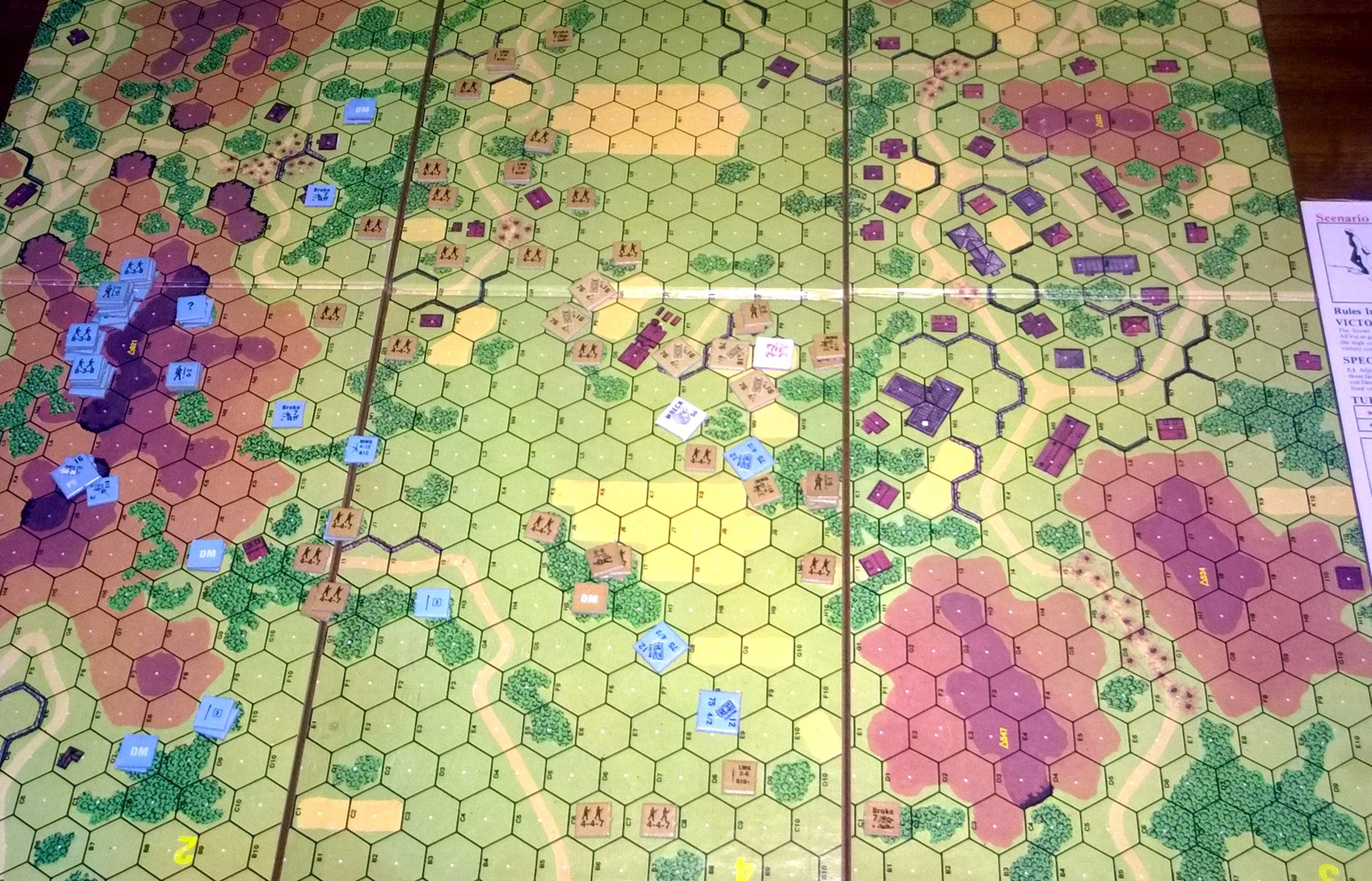
The German tanks had a hard time of it, most being destroyed by the Russian tanks. As far as these things go, the chances of each side destroying the other was pretty much equivalent, but the Russians got luckier. So it goes.
What was more significant was the arrival of the German Rear Area Reserves. In a move that I knew wasn’t particularly good at the time, they all got placed on the high ridge that the Russians were making their way towards. The advantage they had is that from the ridge, they could see – and shoot at – most of the battlefield. Having machine-guns is important! The drawback is that they had no cover on the ridge, and soon the drawbacks of that would be demonstrated to them brilliantly.
A few turns early, the Germans had set up their first A-T Gun on the other high-points, and it was causing one or two troubles for the Russian tanks.
One other factor in the battle was the Off-Board Ordnance the Germans were using against the Russians. It had little effect on their tanks, but the infantry was disrupted by it. It had a relatively minor effect, however, just because there were so many Russian infantry units… although, by now, the number had been reduced by half!
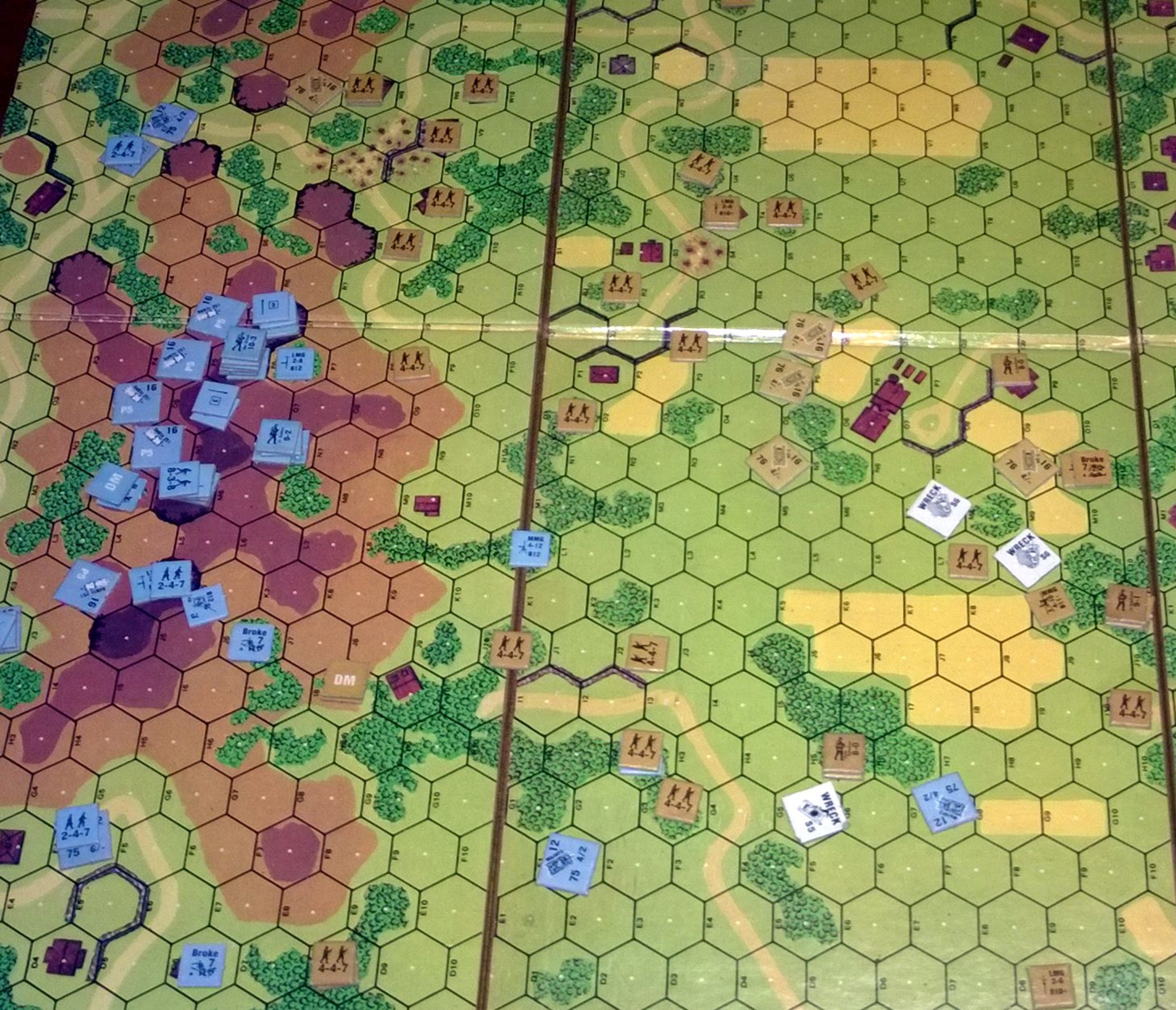
One of the great elements of design in Squad Leader is how it treats squads. During the design process, John Hill realised that the state of infantry units could be modelled with three basic states: fine, discomfited and eliminated. So, in the design, whenever a unit takes fire it can become one of those states. The actual rules for resolving fire are very simple – the most complicated rules deal with defensive fire while the opponent is moving – and it helps the game run smoothly.
Infantry moving in the open is terrible vulnerable, and that’s the fate that befell most of the Russian troops.
However, troops in the open can survive quite well when they outnumber the opponent; there’s only so many units a lone defender can take on! The rules for defensive fire would become quite a lot more involved as the system developed; at the moment, it’s basically each defender making one attack against opposing units, so numbers are extremely important.
The advantage the Germans normally have is a superior number of leaders. A unit that is broken stays broken until it can be rallied by one of the special leader units. The Russians had all of three leaders between 48 squads in the first part of this scenario; the Germans have two between 8 squads! However, this presumes the leaders can get to their men, which was not always the case.
The troops on the ridge were slowly whittled down, and things started getting really bad for the Germans when the Russian Assault Brigade entered the map, with many assault engineers riding on tanks. The biggest problem the Germans had was one Russian tank sitting behind the ridge, which made it impossible for German units to rout – instead, they’d often get eliminated, which was really bad for the already numerically-challenged Germans!
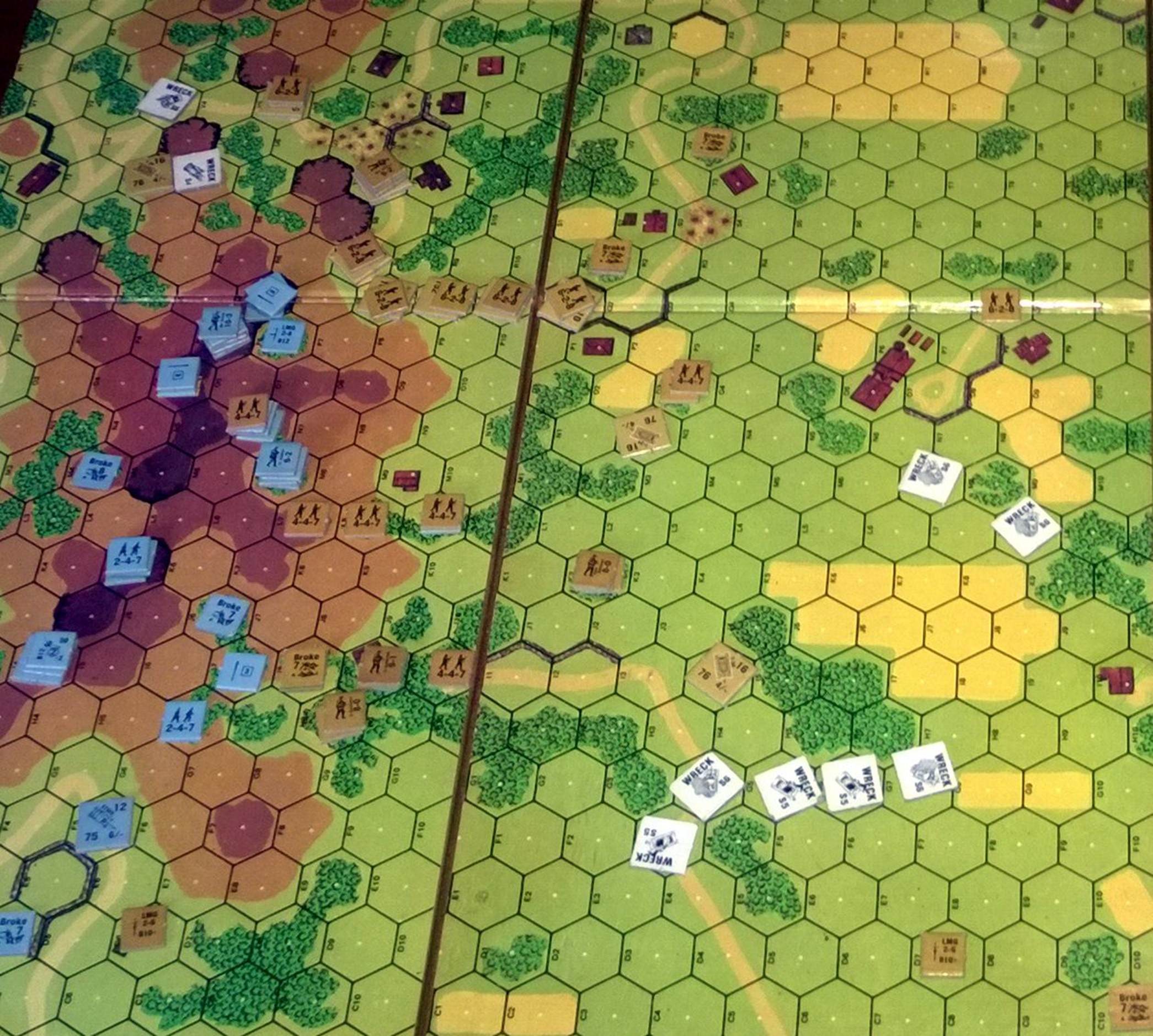
It was clear that the Germans needed to get rid of that tank. So, they sent their last reinforcement – a STGIII – directly at it.
The odds were in the Germans favour, but the luck wasn’t. The STGIII died from the second shot of the Russian T-34, and it was free to move up the ridge and overwhelm the remaining German defenders.
Those German units that remained mounted a brave defence, but the numbers were against them. It’s hard fighting Russian tanks without tanks, and although the Germans did have Panzerfausts, the bulk of their supply were sitting up on the ridge where their routing troops had left them.
The Russians claimed the ridge after their machine-guns finally managed to silence one of the Russian A-T Guns, and – at last – the fighting came to an end.
It took until the very last turn of the scenario, but the Russians had won the scenario in the end!
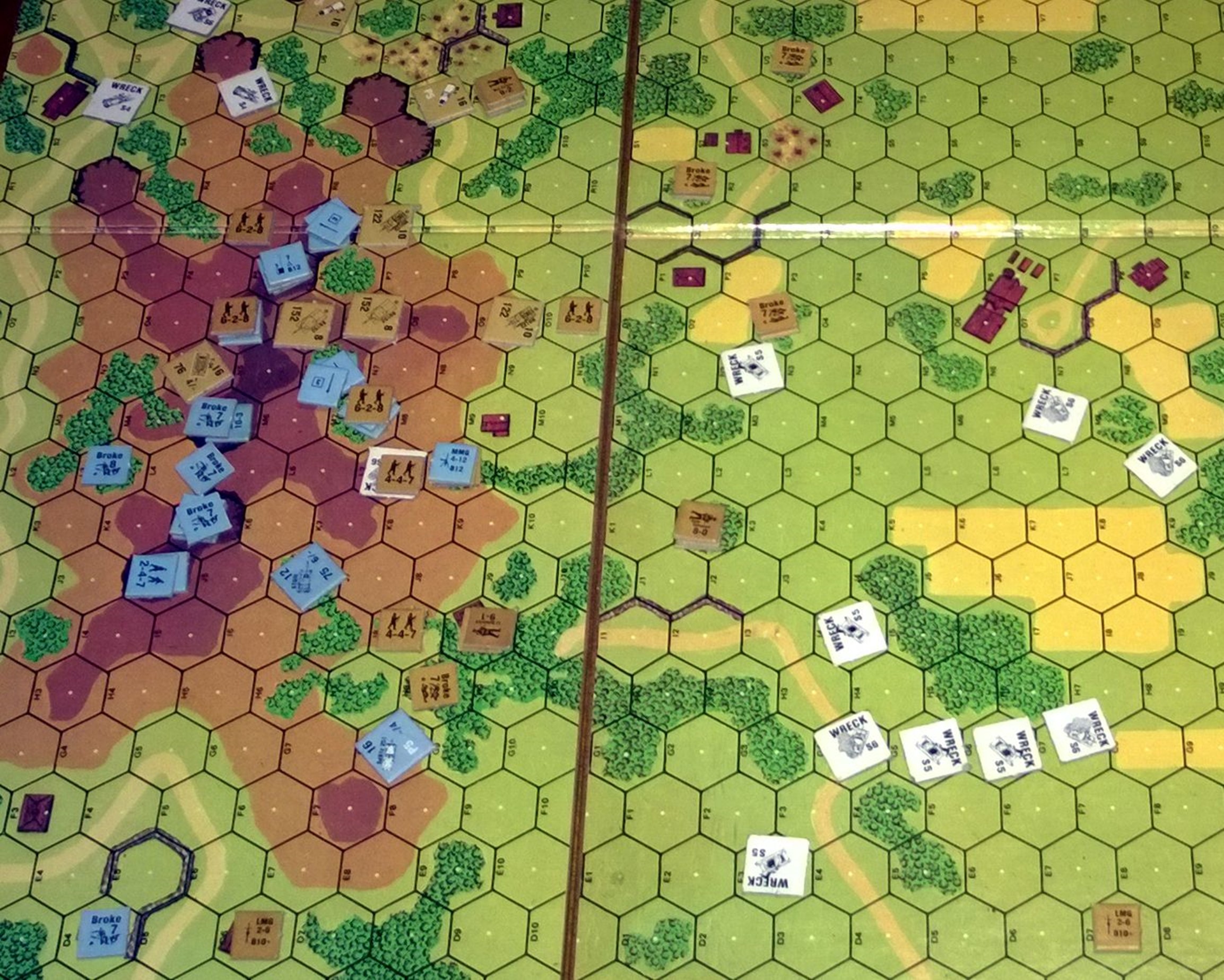
This then was the scenario of Hill 621. As in actual history, the Germans put up a brave defence the Russians overwhelmed them. On July 3rd, 1944, the Soviets entered Minsk, the former headquarters of Army Group Centre.
When Squad Leader was released, I was 4. It’s now 38 years later. It entertained thousands upon thousands of people when it was originally released, and I’m enjoying it today.
John Hill died today. Thank you, Mr Hill, for your great game.

An interesting and enjoyable article. I wonder what the author means, though, when he says “the war-game era”? Wargames in the modern commercial sense have been with us since 1958 or so and Roberts’ “Tactics” game. There are more wargame titles being produced now, in a single year, than in probably the first 10 years of the hobby combined. In other words, I don’t think the “era” has yet ended. Some people argue about when the “golden age” of these games was – perhaps that is what the author meant? – but here, too, some are willing to think we’re still living in that age. Regardless, this is a well-done article and captures nicely some of the attraction this title had – and still may have. I was a little older than the author when I became aware of Squad Leader, and have fond memories not only of seeing the handsome bookcase style box in the local toy store (its stark graphics and difficulty warning on the back made it seem very sophisticated), but of trying to convert schoolmates and other friends to enjoying it as much as I did.
The “wargame era” for me is when wargames sold a LOT of copies. I fully agree that today’s games are fantastic and there’s a lot of them, but few actually sell anywhere near the numbers that the best-selling games of the 70s. Personally, I think today is a true golden age of wargame design – I delight in the new titles put out by GMT Games, MMP and other publishers – but the sales just aren’t there for most of them. Which is a real pity, because there are a lot fantastic games being produced.
(My view of “tabletop” eras goes: Wargaming -> RPGs -> CCGs -> Boardgames, although at some point computer games start swamping the sales of the tabletop market.)
I started playing squad leader in 1980 with a neighborhood friend. When we finally acquired Cross of Iron we both liked the size and units and the scenario of hill 621 – over the course of a year we played about 25 games of hill 621.
We alternated who played the Germans and the Russians – ultimately the Russians won 17 times and the Germans about 8. Fascinating scenario – if the Germans get off to a bad start it is near impossible to win. I still play this one every once in a while – most enjoyable….